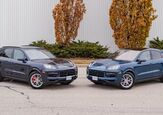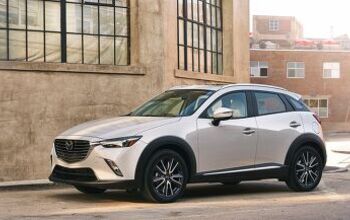2025 Polestar 3: Pros And Cons

The brand’s first SUV is impressive—but not without flaws.
Polestar is gearing up for prime time. After a limited-production coupe and a boxy EV sedan, the brand is finally building a vehicle in the shape North Americans love: the SUV. Polestar is building the SUV right here in America, too.
I drove the Polestar 3 earlier this month and came away largely impressed. It has a handful of stand-out features: some good, some bad.
Pro: Drive Settings
Like so many modern cars, the P3 has quite a few adjustable settings to tailor the driving experience. Open up the menu and there are settings for power delivery, suspension, steering weight, and more.
And it all works. There’s an appreciable difference between the lightest and heftiest steering feel—and the middle one is best. The suspension settings go further: even the default setting is well-damped with friendly, eager turn-in. Instead of the usual “sport” or “sport plus” options you’ll find “nimble” and “firm.” While the latter is just that, nimble really does bring increased agility without a harsher ride.
There’s one small catch, however.
Con: Model Choices Don't Matter
I drove both the regular dual-motor and Performance Pack models at the event. With all the options thrown at the former, it rode on similarly sized wheels and the same tires. It gives up just 28 horsepower to its pricier sibling, and assuming the curb weight is on average 5,791 pounds (2,627 kg — the middle of the range of weights Polestar provided), that means every pony has to haul 11.84 lb. The Perf Pack? 11.2. It’ll shave a couple of tenths off the dash to 62 mph (100 km/h), but c’mon: nobody is buying this for drag racing.
Polestar says the Performance Pack comes with a uniquely tuned chassis, but back-to-back around the roads in Wyoming, the changes bordered on academic. There might be some slight increase in ride stiffness, but not enough to alter the experience.
Pro: Big Infotainment Improvement
The Polestar 2’s infotainment was fine. The 3’s is much better. Not only is the display big and beautiful, it’s straightforward to operate. Polestar has added little graphics and animations for most options, not only making it easier to use at a glance but providing additional information on what everything does. Tap an icon and an explanation will come up—best to read while parked, of course.
Con: Usability Hang Ups
Want to adjust your mirrors or steering wheel? Navigate to the dedicated screen to do so, then select the bit you want to adjust, then move it via the wheel-mounted controls. It’s forever awkward, though I’ll readily acknowledge as an owner, you’ll do it precisely once, save it to a driver profile, and never think about it again.
But there are other catches. Making small adjustments to your seat is pretty common on longer drives, right? Start to do it here and the seat adjustments pop up onto the central screen, putting a pause to any other activities there. Adjusting the different parts of the seat requires a press of the central adjuster button—but those changes regularly lagged behind on-screen. Massaging front seats are good, but it takes no less than four taps to even get to the menu. Even there, the programs are simply numbered, so you’ll have to poke each to know which is which.
The issues extend beyond the touchscreen, too. No vehicle on/off button means certain features may or may not work if you’ve parked and happened to open the door. The key-as-card feature Polestar used at the event saw inconsistent door locking too. The P3 is still waiting on some features as well: no gap adjustment for the adaptive cruise control, no audio controls on the steering wheel… you get the idea.
Pro: Smart Cabin Design
Not making excuses for those tech features, but they can be fixed via software updates. That’s a much harder, much pricier affair when there’s a problem with physical equipment, so it’s good the Polestar 3 has an excellent cabin right at launch.
The dashboard design is expectedly minimalist—and yes, similar to that of the EX90—with high quality materials and precise fit and finish. It’s more than just surface-level, too: take the small, grippy insert in the door handles, or the carbon footprint stats on the Nappa leather seats. The shiny black plastic in the center console is the one miss here.
Overall, the Polestar 3 is an impressive new entry in a very competitive segment. Will it be a hit? It’s too early to tell, but Polestar will need to build on these strengths and fix the issues for the best chances.
Become an AutoGuide insider. Get the latest from the automotive world first by subscribing to our newsletter here.

Kyle began his automotive obsession before he even started school, courtesy of a remote control Porsche and various LEGO sets. He later studied advertising and graphic design at Humber College, which led him to writing about cars (both real and digital). He is now a proud member of the Automobile Journalists Association of Canada (AJAC), where he was the Journalist of the Year runner-up for 2021.
More by Kyle Patrick




































Comments
Join the conversation
So, how can you do a review a Polestar without investigating the potential impact of a Chinese software ban? Polestars sold in the US are assembled in the US but all cars these days, not just EV's are heavy on computers and software. Also, your readers may be surprised to know that at over 5700 pounds, they are heavier than a 1/2 ton pickup truck? Finally, when evaluating an EV, your readers really need an evaluation of battery packs and the ramifications of battery replacements. Read the horror stories on the Hyundai Ioniq where apparently replacing the battery pack is an all or nothing deal. This isn't just because batteries get old. Otherwise minor accident damage requires replacement of the whole pack; not just parts. This costs more than the price of the car so a minor accident can result in the car being totaled. This is NOT true of all EV's so for buyers this is an essential thing to know about a car before buying and should be included in any EV review.
Thank you automotive journalists everywhere for fawing all over these giant touchscreens of useless Software operated Vehicles when simple bttons, switches and knobs will do it in half the time each and every time. Did i mention at a lower cost too?